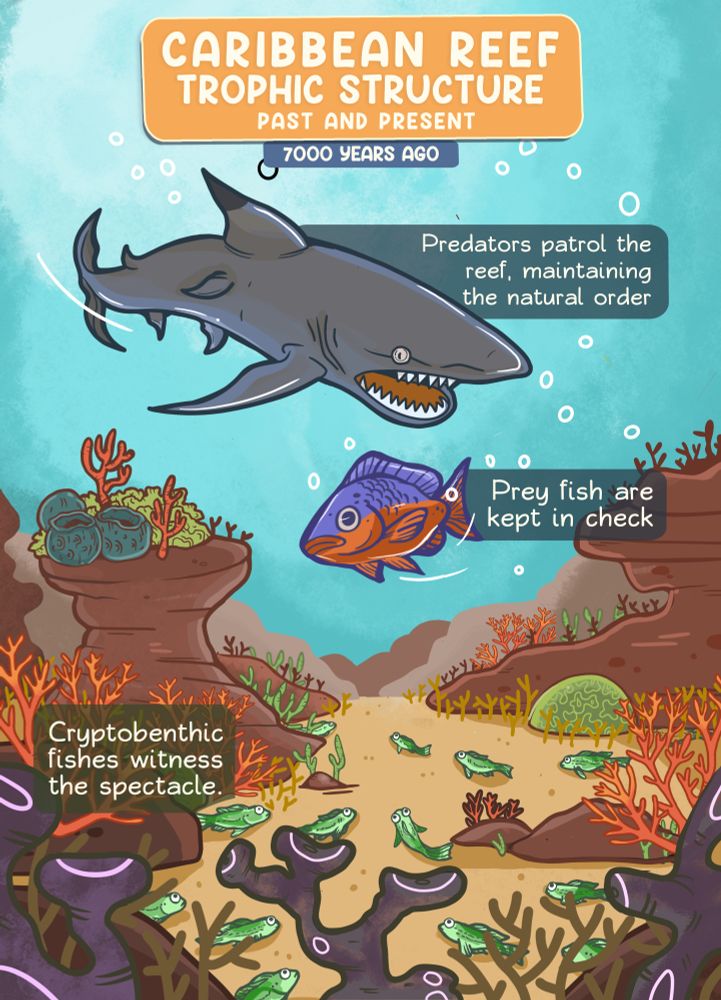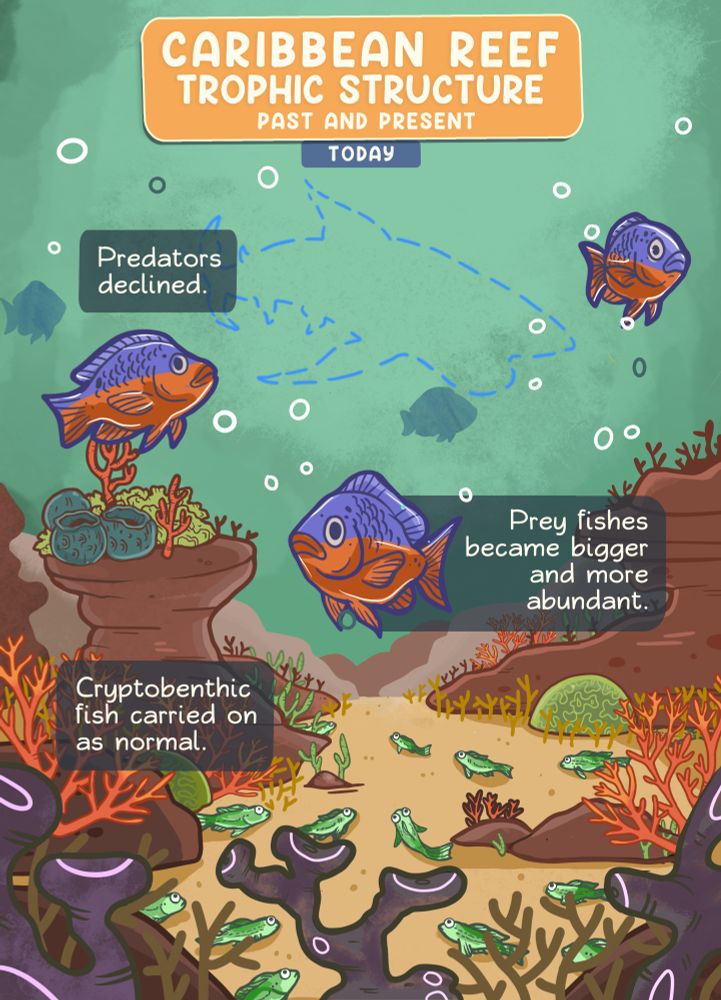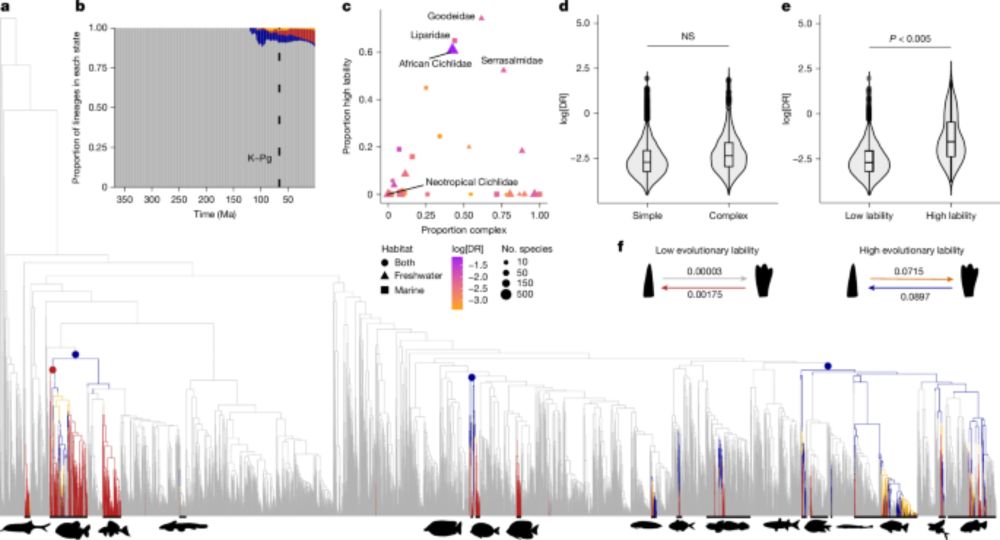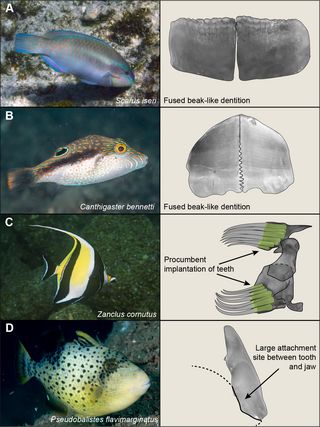
Coral reef conservation is under pressure to act boldly in the face of climate-altered futures.
But how do we choose sustainable, responsible options?
Here, myself, @proftiffanym.bsky.social & David Bellwood introduce "MIMO". 👇
@cp-cellrepsustain.bsky.social
www.cell.com/cell-reports...
14.10.2025 22:00 — 👍 8 🔁 6 💬 1 📌 1
Our paper on Nautilus sex determination made the cover of @currentbiology.bsky.social !
With @reef-combo.bsky.social @anariesgo.bsky.social and Hector Torrado!
@leibnizlib.bsky.social
Check it out now!
24.09.2025 16:25 — 👍 24 🔁 12 💬 0 📌 1

New species alert! A Pascua goby from the Coral Sea. This genus now contains four species. Two from the Eastern Pacific and two from Australia, with more than 5,500km separating them. Lots of fun describing my second new species. #TeamFish #Fish
doi.org/10.3390/fish...
04.09.2025 10:15 — 👍 14 🔁 5 💬 1 📌 3

JOB OPPORTUNITIES with Guam Coral Reef Initiative (Five openings!)
www.guamcoralreefs.info/opportunities
#coralreefs #coralrestoration #jobs #careers #guam #restorationjobs #reefrestoration #coralreefecology #waterquality #marinebiology
03.09.2025 05:30 — 👍 3 🔁 1 💬 0 📌 0
Congrats Emily! Great work!
02.09.2025 00:34 — 👍 2 🔁 0 💬 1 📌 0

A bignose unicornfish, dark fish with yellowish fin edges, vertical bars on the body, and double scalpel blades at the base of the tail.
Naso! Great genus of surgeonfishes, sporting the vicious cutting scalpel blades at the base of their tail. Here is a better color photo of that bignose where you can see the tail blades.
🐟🦑🧪🌎
26.08.2025 03:47 — 👍 30 🔁 6 💬 0 📌 1

The lined surgeonfish, with beautiful blue and yellow lines on the body and orange pelvic fins

The regal angelfish, with stunning blue, orange and white bars and a bright yellow tail
Acanthuriform fishes! Research goals on Moorea are focused on morphology and evolution of defensive spines and backbones of surgeonfishes, angelfishes, and butterflyfishes. We have a scientific permit to collect specimens, and here are 2 beauties, Acanthurus lineatus and Pygoplites diacanthus. 🐟🦑🧪
21.08.2025 20:14 — 👍 9 🔁 4 💬 2 📌 0
Devonian ray-finned fishes were not particularly species rich, particularly compared to their lobe-finned cousins. This implies early actinopts might've also been anatomically monotonous. But a deep dive into their jaw anatomy w/ µCT reveals subtle but important structural diversity.
22.07.2025 21:11 — 👍 33 🔁 9 💬 1 📌 0


🐠🦈 Just out: In this paper we ask "How has reef trophic structure changed since humans started removing predatory fishes from Caribbean coral reefs?".
www.pnas.org/doi/10.1073/...
Illustrations @cookedillustrations.com
01.07.2025 18:36 — 👍 75 🔁 39 💬 5 📌 3
Thanks Bill! 🙂
06.05.2025 22:15 — 👍 0 🔁 0 💬 0 📌 0
Thanks Liz! 🙂
06.05.2025 22:14 — 👍 1 🔁 0 💬 0 📌 0

How are they biting? High-speed video reveals unexpected jaw movements in reef fish
Some reef fish have the unexpected ability to move their jaws from side to side, biologists at the University of California, Davis have discovered.
High-speed video shows that some reef fish can move their jaws side to side, a rare trait among vertebrates that enables efficient feeding on algae growing on rocks and in crevices. doi.org/g9hg4h
05.05.2025 22:02 — 👍 3 🔁 1 💬 0 📌 0
Super excited that our new paper is out today in
@pnas.org. Title: Lateral jaw motion in fish expands the functional repertoire of vertebrates and underpins the success of a dominant herbivore lineage.
www.pnas.org/doi/10.1073/...
06.05.2025 05:28 — 👍 19 🔁 10 💬 1 📌 1
10/10 We suggest that the evolution of many other traits, not typically considered key innovations, could affect species diversification in this way.
04.03.2025 05:37 — 👍 1 🔁 0 💬 0 📌 0
9/10 These results suggest that the combination of uniquely high evolutionary lability and the ecological versatility of complex teeth drove rapid diversification of cichlids in Lakes Malawi, Victoria, and Barombi Mbo. A new explanation for why these groups diversify so rapidly!
04.03.2025 05:37 — 👍 2 🔁 1 💬 1 📌 0

8/10 But having complex teeth is still a benefit. When lineages have complex teeth, they switch between different diets at much faster rates. This ecological versatility is elevated because complex teeth allow transitions through herbivory and omnivory.
04.03.2025 05:36 — 👍 3 🔁 0 💬 1 📌 0

7/10 When we fit SSE models, we find lability (greens) consistently increases speciation rate, despite high background rate variation. So, differences in lability explain speciation rate differences within rift lakes AND across habitats – separating out the “rift lake” effect.
04.03.2025 05:36 — 👍 1 🔁 0 💬 1 📌 0

6/10 Investigating this with more complex Bayesian models, we find that even within African cichlids, there are differences in lability. Lability is much higher in Lakes Malawi, Victoria, and Barombi Mbo – exceptional adaptive radiations.
04.03.2025 05:35 — 👍 0 🔁 0 💬 1 📌 0
5/10 But the distribution of high lability is uneven. This is concentrated within African cichlids (and NOT neotropical cichlids). The prevalence of lability of tooth complex in African cichlids is unique!
04.03.2025 05:34 — 👍 0 🔁 0 💬 1 📌 0
4/10 Comparing the effects of complexity and lability, we find it’s lability that increases speciation rates by 5x! So, rapidly gaining and losing tooth complexity has a much stronger effect than complex teeth alone – a new way to think about key innovations.
04.03.2025 05:33 — 👍 0 🔁 0 💬 1 📌 0
3/10 Complex teeth (e.g. molars) are a key innovation for mammals and squamates. We find in fishes, they evolve many (>86) times but remain rare (~11% of species), evolving slowly across most of the tree. But in a few groups, the rate is significantly increased – evolutionary lability.
04.03.2025 05:33 — 👍 2 🔁 0 💬 1 📌 0
2/10 Key innovations are thought to rarely evolve with massive effects on diversification. Species differ in capacity to evolve new traits; differences in how innovations evolve has been overlooked. This variation could have strong effects if the trait is linked to ecological divergence.
04.03.2025 05:32 — 👍 1 🔁 0 💬 1 📌 0

Evolutionary lability of a key innovation spurs rapid diversification - Nature
A study shows that the rapid diversification of cichlids in African lakes is driven by their ability to evolve between having simple or complex teeth.
1/10 *** New paper out *** (on behalf of Nick Peoples who is not on Bluesky). I am beyond excited to present our new paper out now in @Nature! Here, we show that rapid gain and loss of tooth complexity accelerates diversification in fishes! www.nature.com/articles/s41...
04.03.2025 05:32 — 👍 28 🔁 9 💬 1 📌 1

uog.peopleadmin.com/postings/4332
Join us at the University of Guam!
Assistant Professor position in Marine Microbiology 🐟
12.02.2025 12:12 — 👍 1 🔁 0 💬 0 📌 0
Evolutionary biologist & paleontologist. Website: http://bit.ly/JTCsite Macroevolution, phylogenetic comparative methods, diversification, phenotypic evolution of 🐠🌿🦋 Postdoc @iDiv in Leipzig
Researches marine predator movement & energetics with a focus on feathery, flying taxa
🌐 ruthedunn.com
🐧 𝘴𝘩𝘦/𝘩𝘦𝘳
📍 CNRS Postdoc, Montpellier
Systematic, evolutionary history, and taxonomy of stony corals.
🌊
Postdoctoral researcher at the Smithsonian Natural Museum of Natural History.
Asst Prof @ Georgia Tech. Evolutionary ecology using lizards 🦎🦎🦎 most interested in connecting micro-scale processes to macro-scale patterns
Professor of ecology and evolution @ UConn. Studies adaptation, evolutionary immunology, speciation, genomics, foraging, parasite ecology and more.
Hikes, rock climbs, tango, history buff, photographer & parent
We work with people and communities to create enduring solutions for just societies and a healthy, resilient natural world.
Vertebrate paleontologist and evolutionary biologist, currently postdoc at LMU Munich. In a love-hate relationship with phylogenies :D
Postdoctoral research fellow in Just Ocean Governance, studying the functions of complex marine social-ecological systems. At University of Melbourne, WorldFish, and James Cook University
Postdoctoral Researcher at the Smithsonian Tropical Research Institute | Fish and Fisheries | Marine Historical Ecology
CEB PhD Candidate at UChicago/Field Museum | Westneat Lab
evolutionary ecomorphology, venom delivery in fishes, teaching
Chicago Cubs Fan | runner | hotdog enthusiast
https://linnealungstrom.weebly.com/
Research Scientist at Southern Cross University
Into weird fishes, anything ocean related, environmental DNA, and estuaries
Leibniz-Institut zur Analyse des Biodiversitätswandels (Bonn & Hamburg)
Leibniz Institute for the Analysis of Biodiversity Change (Bonn & Hamburg)
#biodiversitychange #collections #naturalhistorymuseum #outreach #exhibitions #evolution #taxonomy #genomics
Professor of Population Genetics, Guam
Evolutionary Genomics, Marine Biodiversity, Corals, Molluscs, Sponges…
Evolutionary Biologist of Squishy Marine Creatures. #Molluscs #corals
#Marine #Invertebrate #Genomics
@leibnizlib.bsky.social
🐚🪼Publishing research that uses systematics to advance palaeontology🐾🐟
📃Our papers:
https://www.tandfonline.com/journals/tjsp20
🏛️We're based at the Natural History Museum, London:
https://www.nhm.ac.uk/business-services/publishing/Journals
Fish Scientist & Prof, aka “The Gar Guy” | 🌎Freshwater Conservation | SciComm • GarLab | Views mine | he/him | #GarWeek
Wherever you go, there you gar
https://linktr.ee/solomonrdavid • @garlab.bsky.social
This account spotlights manuscripts & authors from from The Society for Integrative and Comparative
Biology's(sicb.bsky.social) journals- ICB & IOB (OA) -header art done by Noah Bressman
Behaviour, ecology and evolution of coral reef fishes. Senior lecturer at Newcastle University www.drtrueger.com
Marine biologist at the University of Southampton. Researching reef fish ecology and evolution and the awesomest fish in the sea - gobies. 🐠🪸🇬🇧🇪🇺🇭🇲🏳️🌈
I work on fish molecular ecology. I like to dive, sail, fly, rock climb, and motorcycles. But mostly, I like fish.... 🇮🇹 🇫🇷





















